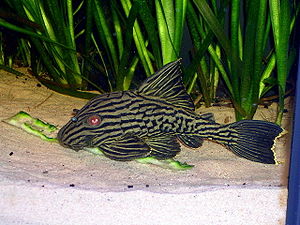Panaque
| Panaque | ||||||||||||
|---|---|---|---|---|---|---|---|---|---|---|---|---|

Panaque nigrolineatus |
||||||||||||
| Systematics | ||||||||||||
|
||||||||||||
| Scientific name | ||||||||||||
| Panaque | ||||||||||||
| Eigenmann & Eigenmann , 1889 |
Panaque is a genus of small to medium-sized South American armored catfish , which is also remarkable because it is one of the few vertebrates that feed almost exclusively on wood . Their diet is supplemented by algae and growth that they scrape off stones with the help of their rasp teeth. Panaque species are also often kept in aquariums, where the scratching noises of fish looking for food can be easily heard.
Word origin and pronunciation
The name Panaque is a Latinization of the Venezuelan name panaqué for Panaque species, which is also pronounced [ ˌpanaˈke ] (in North America with an English accent [ ˌpænɑˈkeɪ̯ ]). In France, Great Britain and Australia it is pronounced French [ panak ] (with an English accent [ pəˈnɑk ] or [ pəˈnæk ]). The Japanese call Panaque species panakue [ panakɯɛ ].
distribution and habitat
All Panaque species come from tropical South America, and are primarily found in the Río Magdalena , the Orinoco , the Amazon , the Essequibo and the drains of the Maracaibo Sea . They colonize fast flowing streams and rivers. Although they are not good swimmers, they have a powerful suction mouth with which they can suck on stones and wood.
features
Similar to other members of the family of armored catfish have Panaque a strong hardened horny scales called Scuta, armored body. Like all other armored catfish, the Panaque has no scales . In addition to their armor, they have strong multi-rayed dorsal and pectoral fins. They mostly use them for defense, either to wedge themselves in crevices where enemies cannot reach them or to prevent being swallowed by them. Another characteristic is the presence of an iris flap (umbraculum). (The majority of fish cannot regulate the amount of light entering the eye because their irises cannot change their size.) Both male and female panaques develop on the sides of the head and near it, as well as on the pectoral fin with advancing age and reaching sexual maturity bristle-like structures, the so-called odontodes .
In contrast to the predatory catfish, these vegetarian catfish only have very short barbels . In the picture above they are as short, dotted structures on both sides of the sucking mouth. With the help of this mouth they can suck in on stones and roots and thus stay there for a long time with little effort.
In the course of their development, Panaque have ideally adapted to their wood-rich diet and have teeth that function like a scraper and an intestinal flora that allows the fish to digest wood.
species
- Panaque armbrusteri Lujan, Hidalgo & Stewart, 2010
- Panaque bathyphilus Lujan & Chamon, 2008
- Panaque cochliodon ( Steindachner , 1879)
- Panaque nigrolineatus ( Peters , 1877)
- Panaque schaeferi Lujan, Hidalgo & Stewart, 2010
- Panaque suttonorum Schultz, 1944
- Panaque titan Lujan, Hidalgo & Stewart, 2010
Aquaristics
Some Panaque species, especially the strikingly colored Panaque nigrolineatus , are popular aquarium fish. Also known as the "Royal Panaque" or "Royal plec" because of its high price, this fish is often sold as an "algae eater" in pet stores. The coloring of the Royal Plecs consists of thick, dark blue-black stripes on a gray-green background. The fins have a gold or cream colored hem and red eyes. In captivity, these fish grow to around 30 cm.
A second species, Panaque cochliodon , may be known to many aquarists as the "blue-eyed plec". This fish was primarily traded in the 1980s and 1990s, but has recently been rarely imported as wild-caught from its natural habitat in Colombia . In stock lists of dealers this is often called Panaque suttonorum or suttoni Panaque out, whereas it was completely different, is a Venezuela native species. "Blue-eyed Plecs" reach roughly the same height as the Royal Plecs. Once they are used to their surroundings, they are just as easy to care for as the former.
All Panaque have roughly the same care rights in captivity. Mainly, they need a balanced diet consisting of green algae and fresh vegetables. Carrots, zucchini and fresh spinach are popular. In their natural habitat, the fish feed almost exclusively on algae and wood. The Panaque can do without carnal food like other "Plecs" need. Since the fish can grow relatively large, they should only be kept in a sufficiently large tank with good filtration. As far as the water values are concerned, Panaque are very frugal, but prefer soft, slightly acidic water.
Panaque are peaceful, nocturnal fish that are easy to socialize with other fish. Since they form territories, only a few panaques should be kept together in one pool.
Web links
- Panaque on Fishbase.org (English)
- Panaque Research Studies on the wood eating loricariid catfishes accessed June 23, 2007

